| Theognosian Church L'Eglise theognostique Chiesa Teognostica الكنيسة اللاهوتية الملحد | |
|---|---|
 | |
| Abbreviation | TC |
| Type | Hosian |
| Theistic philosophy | Monotheistic, Binitarian |
| Supreme divinity | Elyon |
| Major Prophets | Ariel, Eliyahu, Arch-Patriarch Pius II |
| Last Arch-Patriarch | Benedetto V (3856-3876) |
| Headquarters | Ville de Saints |
| Founder | Arch-Patriarch Pius II |
| Founded | 2154 |
| Separated from | Terran Patriarchal Church |
| Merged into | Aurorian Patriarchal Church |
| Defunct | 3876 |
| Liturgical language | Canrillaise, Luthorian, Istalian, Majatran |
| Liturgical rite | Theognosian Rite |
The Theognosian Church was a major Patriarchal Hosian church in Terra from when it split from the Terran Patriarchal Church in 2154 to when it merged into the Aurorian Patriarchal Church in 3876 following the Second Council of Auroria.
In 3861, the Second Council of Auroria saw the Theognosian Church and the Selucian Patriarchal Church restore communion within a restored Holy Apostolic Hosian Church of Terra under a new Arch-Patriarch at Auroria, thereby merging into the Aurorian Patriarchal Church. The Theognosian Church traditions remain alive as part of the new body, especially in the Theognosian rite and the Theognosian Patriarchate at Ville de Saints.
History[]
The Theognosian Church, referred to by many of its followers as the Holy Church, was founded in 2153 after the Patriarchal Schism of the year before. For several years Arch-Patriarch Innocent I of the Terran Patriarchal Church had begun a series of infamous Cadaver Synods in which all the Kardinals in Terra tried a series of deceased clergy, saints and former Arch-Patriarchs, seemingly in order to discredit their legacies and pave the way for the reversal of administrative and theological changes. The highest profile of these Cadaver Synods, and the most controversial, was the trial of deceased former Arch-Patriarch Pius II.
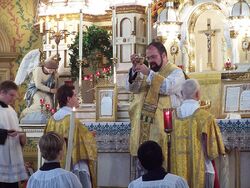
Theognosian rite of Eucharist.
The Cadaver Trial of Arch-Patriarch Pius II[]
The cadaver trial of Pius II ran for several months, and in an unprecedented move the Church ordered the disinterment of Pius II's body to physically sit on trial. Arch-Patriarch Pius II who was found guilty of perceived crimes against the Holy See and his cadaver was stripped of all Papal Regalia while his theological contributions outlawed. These actions did not sit well with a small but vocal minority of clergy and lay people (as well as a large number of parishioners) who quickly began an internal Church campaign to undo the damage of the trial. However, Innocent's supporters held firm and refused to undo the changes.
Unbeknown to the Innocent I the body of Arch-Patriarch Pius II was mutilated and thrown into the Alazinder River. Several clergymen loyal to Pius II retrieved the body from the river and smuggled it away to Quanzar. Upon hearing of what happened, Arch-Patriarch Innocent excommunicated the clergymen who had disposed of the body but irreversible damage had been done. The public was outraged at reports of Pius' body being disposed of in the river.
The Patriarchal Schism of 2154[]
Many of Arch-Patriarch Pius' Terran Patriarchal supporters struggled in vain for over a year to repair the damage done to the Church but by late 2154 all seemed lost and they left the Church in droves along with large numbers of parishioners.
In December of 2154 the body of Pius II emerged in Kanjor along with 500 Terran Patriarchal]] dissident clergymen and their families who settled in the town of Saint-Claire in the Martois région of Kanjor in southern Seleya. Here they formed the Theognosian Church following the theological precedents developed by Arch-Patriarch Pius II and several other Cadaver Synod victims using the body of Arch-Patriarch Pius II as its source of legitimacy. This came to be known as the Patriarchal Schism of 2154.
The Dark Ages[]
The period after the Church's inception is often referred to as the "Dark Ages". The period witnessed the struggling of the Church simply to survive the efforts of the Terran Patriarchal Church to de-legitimize and destroy it. Funds were low and the Church Fathers had difficulty developing new and independent precedents for the Church as debates continued to rage over whether to continue or dismiss Terran Patriarchal traditions. The Church numbered only 10,000 followers and was top heavy with clergy. This period would last until the 24th century when mass conversions began in Rildanor and Kanjor following many controversial changes within the Terran Patriarchal Church.
Theognosianism soon attracted supporters from all over the globe; mainly in Canrillaişe-speaking nations such as Alduria, Kanjor, and Rildanor, but soon spread to places as diverse as the eastern majatran territories, first of all Quanzar, as it was known at the time Istalia, Solentia and part of Kafuristan, then in Darnussia, Keymon, Lodamun, Lourenne and Tukarali.
Beliefs[]
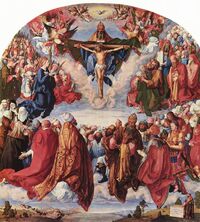
Theognosian depiction of Elyon and Eliyahu surrounded by Scriptural figures, Apostles, and Church founders.
Eliyahu of Yishelem[]
Patriarchalists believe that Eliyahu is an emanation of God, the "Spirit of God", through whom he created Terra. They believe that Eliyahu did not die, but went to exile in Heaven to return at the end of days. He will reveal himself again when Terra is ready, and establish his Kingdom. It is believed that Eliyahu's mission on Terra included giving people his word and example to follow, as recorded in the Annunciation. Patriarchalism teaches that following the example of Eliyahu helps believers to become closer to him, and therefore to grow in true love, freedom, and the fullness of life.
Faith and Reason[]
Following the Holy Fathers, Theognosianism uses science and philosophy to defend and explain its Faith. The Church does not seek to reconcile faith and reason instead it makes no effort to prove by logic or science what Eliyahu gave His followers to believe. However, if physics or biology or chemistry or philosophy lends support to the teachings of the Church, it does not refuse them.
Theognosianism is not intimidated by man's intellectual accomplishments and therefore does not bow to them nor change its version of Hosian Faith to make it consistent with the results of human thought and science. Because of this, many critics believe the Church is an opponent of scientific advancement and inquiry.
Icons[]
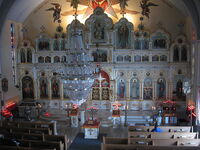
The importance of Icons in Theognosianism is shown on the Iconostasis behind the main altar of this cathedral in Rildanor.
The icon is an artistic depiction of Eliyahu, Sarahea his mother, and the Saints. Elyon (God) cannot be painted, because He has never been seen. The Spirit of God, Eliyahu, became a man, and He may be painted in His human form. Icons are more than sacred pictures. Everything about them is theological. For example, they are always flat, flat so that we who inhabit the physical world will understand that the world of the spirit where Eliyahu, His Mother, the angels, the saints, and the departed dwell, is a world of mystery which cannot be penetrated by our five senses.
Including statues in its worship is also allowed. The statues are life-like and three-dimensional. They seem to imitate the art of ancient Selucia. Both arts are naturalistic. The icons portray Eliyahu, his mother, the saints, even the angels, as if they were in a state of nature. This "naturalism" stems from the medieval idea that "grace perfects nature." The person or persons are represented on the icon as deified. He or she is not a perfect human being, but much more: They are transfigured and glorified. They have a new and grace-filled humanity.
Death[]
Theognosianists believe that when a person dies the soul is temporarily separated from the body. Though it may linger for a short period on Earth, it is ultimately escorted either to paradise or the darkness of Hades, following the Temporary Judgment; Theognosianists do not accept the doctrine of Purgatory which is held by Terran Patriarchalism and other Churches. The soul’s experience of either of these states is only a “foretaste” - being experienced only by the soul - until the Final Judgment, when the soul and body will be reunited.
Role of the Church[]
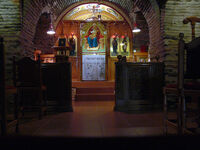
Theognosian churches vary from large cathedrals to small enclaves. This small enclave is found in the basement of an old office building in Istalia.
The Theognosian Church holds that the Church "... is the continuing presence of Eliyahu on earth." The Church structure, therefore, is important in continuing the good work of Eliyahu and Arch-Patriarch Pius II. Interestingly, in keeping with the traditions of Terran Patriarchalism, the Theognosian Church allows all clergy and laymen to marry and raise a family.
Ville de Saints[]
Ville de Saints is the Church's official centre, located in between Rildanor and Kanjor, and home to the Arch-Patriarch and the Curia.
The City was founded around AD 750 as a stop along a migration route for nomadic herders who called the place L'Eau curative des Saints(Healing Waters of the Saints), named after the small spring in the hills said to have healing powers. In 1834 it served as a border stop between the two neighboring nations and a large Hosian Cathedral was built on the site to accomodate the religious practices of the differing garrisons of the town; the Church was agreed to be the only place where both sides attended unarmed.
After the Patriarchal Schism of 2143, the City's Church became a both a point of unity and disagreement between the governments of Kanjor and Rildanor; with both sides rejoicing in their shared religious identity and expressing conflicting claims of legitimacy over the Cathedral. As the new Theognosian Church began looking for a new headquarters, and to separate themselves from the Terran Patriarchal Church. The Church settled on the grand Cathedral in the city and gathered funds to begin lobbying the governments of Kanjor and Rildanor for the donation of the city as their headquarters, which was duly granted in 2340. The Church headquarters was completed in 2375.
Expansion[]
The growth of the Theognosian faithful was consistent over the past few centuries, winning over converts outside of southern Seleya, particularly in northern Seleya, southern Majatra, and Darnussia.
| Arc-Patriarche de l’Église theognostique Arch-Patriarch of the Theognosian Church | |
|---|---|
 | |
| His Holiness the Arch-Patriarch | |
| Michael | |
| Information | |
| Style | His Holiness |
| First Arch-Patriarch of Theognosian Church | Arch-Patriarch Pius II |
| First Formation of Papacy | 2143 (traditional) 2195 (de facto) |
Theognosian Arch-Patriarchs[]
Title: His Holiness, Bishop of Saints, Vicar of Eliyahu, Successor of the Prince of the Apostles, Supreme Pontiff of the Holy Church, Sovereign of the State of the City of Saints, Servant of the Servants of God, and Patriarch of Terra.
(Canrillaise: Sa sainteté, évêque des saints, curé du Élie, Successeur du prince des apôtres, Pontife suprême de l'église sainte, Sovereign de l'état de la ville des saints, Serviteur des Serviteurs de Dieu, et Patriarche du Terra.
Notable Teognosian Arch-Patriarchs[]
Arch-Patriarch Pius II[]
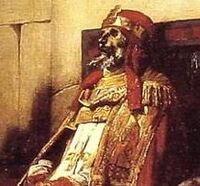
The disinterred body of Arch-Patriarch Pius II on trial during the infamous Cadaver Synod.
Arch-Patriarch Pius II was a Deltarian national born L'ubomir Bátory on 5 December 2108. L'ubomir was the son of Terran Patriarchal Arch-Patriarch Pius I and followed his father into the Church. L'ubomir rose quickly within the ranks of the Terran Church and obtained a position serving as his father's most trusted assistant upon his election to Arch-Patriarch in early 2134.
Arch-Patriarch Pius I fought crippling depression throughout his life and suffered a severe episode during the late summer of 2134. On the evening of 24 August 2134, as L'ubomir began serving dinner his father grabbed a knife from the table and attempted to slit his throat. From his account, L'ubomir "wrestled with the old man for possession of the knife, wounding his face in the process, but he broke away from me and subsequently stabbed himself several times in the chest". L'ubomir explained that these wounds failed to kill his father and so the Arch-Patriarch stumbled upon the sharper knives of the dinner cart and finished the job with a slash to his throat. Amongst the dead Arch-Patriarch's papers was found a document stating that his son, Liubomir Bátory was to become the new Arch-Patriarch.
L'ubomir reluctantly accepted the position and after a month long period of worldwide mourning he was proclaimed Arch-Patriarch Pius II.
As Arch-Patriarch, the newly-christened Pius II brought about many administrative changes through his edicts and theological writings. He declared the Castle Kachetovo near Darali as the new Vatikan, Holy See, and headquarters of the Terran Patriarchal Church. When they refused to support his administrative and theological reforms, Pius II excommunicated the High Synod in retaliation. However, later he reconciled several of those who had "displayed a heartfelt penitence".
Pius II served eighteen years as Arch-Patriarch before voluntarily abdicating the in favor of his rival, Igor Nádašdy. In his retirement, Pius married the Barona Ivanka Nádašyova. However, in 2154, only two years later he died of a massive stroke at the age of 46. A state funeral was held with religious and state leaders from all over Terra in attendance.
Pius II's eternal rest would be anything but peaceful. Within eight months he became the first victim of the infamous Cadaver Synods on the orders of Arch-Patriarch Innocent I, thus throwing Pius and his body at the center of the great Patriarchal Schism of 2154. In a clear attempt to reconcile the warring factions of the Terran Patriarchal Church after the Cadaver Synods, newly-appointed Arch-Patriarch Francis I decreed Arch-Patriarch Pius II a "Saint and Eternal Pontiff" of the Terran Patriarchal Church but by this time the damage to the Church's reputation was irreversible.
Arch-Patriarch Pius II's body currently resides in the Holy Shrine of the Ville de Saints, headquarters of the Theognosian Church located between Kanjor and Rildanor.
Arch-Patriarch François I[]
Francesco Fabiani was born in Dissuwa, Deltaria in 2145, from an Istalian family which left Quanzar, as it was known Istalia at the time, because the anti-religious sentiments at the time in the Union of Quanzari Soviets, furthermore still led by Ahmadi Majtrans, hostile to the istalians, but not much is known of the youth of young Fabiani or Fabianiski (the family, moved before his birth in Deltaria, Deltarianized its name in Fabianiski and the young Francesco was actually registred as Franchesko).
However, it is clear that his parents were strong supporters of Pius II and worked in secret to preserve his legacy. In 2155, the Fabiani family fled back to Quanzar to avoid persecution at the hands of the Terran Patriarchal Church but given the atheist regime of the Union of Quanzari Soviets, they first of all reached the island of Alaria, part of Quanzar but which always enjoyed a very authonomous status and thus became some of the earliest members of the Theognosian Church. After having left Quanzar for the increasingly atheistic policies against the religious beliefs, the young Francesco reached Kanjor where made the decision to become a Theognosian priest.
After more than five years in seminary, Francesco became a priest where he moved up the ranks quickly; attaining a Bishop and then a Cardinal position before the age of 40. In 2195, joined the high ranks of the theognosian dissident in Kanjor, more than forty years after the death of Pius II, Fabiani was crowned as the de facto first Arch-Patriarch of the Theognosian Church in a large Papal Coronation ceremony in Saint-Claire, Martois, Kanjor as Francis I.
As Arch-Patriarch, his first act was to anoint Arch-Patriarch Pius II a "Saint and an Eternal Arch-Patriarch of All Humanity".
Arch-Patriarch Benedetto V[]
Gregorio Augustani, born in Romula in 3799, became a priest in 3824 and bishop in 3839. Since he was a young priest he had a burning desire to recover the unity of the Hosian Churches of Terra. Seeing the devastation caused by the wars on the continent of Majatra during the ninth century of the fourth millennium, he was convinced that the peace of the continent and the world depended on Hosian unity. A divided church could not announce peace and unity without hypocrisy.
From bishop he was appointed as a delegate by Arch-Patriarch Gabriel XII at the Holy Patriarchal Hosian Churches Council, where he distinguished himself as an active promoter of unity.
In 3856 he was elected Arch-Patriarch of the Theognosian Church, assuming the istalian name of Benedetto V, who led the Church to merge with the Selucian Church into the new Aurorian Patriarchal Church which recognized only one Arch-Patriarch. So Benedetto V was the last Arch-Patriarch of the Theognosian Church.
List of Arch-Patriarchs[]
| Arch-Patriarch | Died | |
|---|---|---|
| Pius / Pieux (II)† | 2143†† | |
| François I | 2206 | |
| Léo I | 2210 | |
| Tristan I | 2212 | |
| Pierre I | 2222 | |
| Sylvestre | 2241 | |
| Pierre II | 2247 | |
| Stephen I | 2269 | |
| Sylvestre II | 2292 | |
| Sylvestre III | 2321 | |
| Pierre III | 2335 | |
| Stephen II | 2365 | |
| Charles I | 2381 | |
| Agapetus | 2415 | |
| Tristan II | 2423 | |
| Tristan III | 2444 | |
| Grégoire I | 2459 | |
| Léo II | 2469 | |
| Olivier I | 2490 | |
| Agapetus II | 2529 | |
| Stephen III | 2545 | |
| Léo III | 2560 | |
| Tristan IV | 2578 | |
| Serge I | 2593 | |
| Serge II | 2606 | |
| François II | 2617 | |
| François III | 2639 | |
| Jacques I | 2648 | |
| Grégoire II | 2662 | |
| Martin I | 2669 | |
| Jacques II | 2688 | |
| Francis IV | 2728 | |
| Raphaël I | 2762 | |
| Charles II | 2795 | |
| Tristan V | 2807 | |
| Jacques III | 2826 | |
| Martin II | 2826 | |
| Martin III | 2835 | |
| Martin IV | 2852 | |
| Martin V | 2866 | |
| Jacques IV | 2878 | |
| Charles III | 2886 | |
| Charles IV | 2901 | |
| Raphaël II | 2913 | |
| Raphaël III | 2938 | |
| Charles V | 2955 | |
| Charles VI | 2981 | |
| Gabriel I | 3002 | |
| Martin VI | 3012 | |
| Martin VII | 3030 | |
| Gabriel II | 3041 | |
| Grégoire III | 3078 | |
| Raphaël IV | 3096 | |
| Michel I | 3120 | |
| Raphaël V | 3127 | |
| Grégoire IV | 3145 | |
| Michel II | 3166 | |
| Paul I | 3176 | |
| Michel III | 3198 | |
| Benoît I | 3209 | |
| Benoît II | 3217 | |
| Grégoire V | 3226 | |
| Charles VII | 3232 | |
| Charles VIII | 3241 | |
| Michel IV | 3242 | |
| Sylvestre IV | 3249 | |
| Sylvestre V | 3256 | |
| Gabriel III | 3288 | |
| Paul II | 3289 | |
| Olivier II | 3309 | |
| Chretien I | 3323 | |
| Raphaël VI | 3330 | |
| Bernard I | 3339 | |
| Bernard II | 3345 | |
| Olivier III | 3352 | |
| Sylvestre VI | 3363 | |
| Charles IX | 3378 | |
| Gabriel IV | 3380 | |
| Gabriel V | 3392 | |
| Benoît III | 3399 | |
| Charles X | 3407 | |
| Chretien II | 3416 | |
| Martin VIII | 3422 | |
| Francois IV | 3434 | |
| Charles XI | 3449 | |
| Guillaume I | 3453 | |
| Guillaume II | 3462 | |
| Étienne | 3479 | |
| Charles XII | 3481 | |
| Gabriel VI | 3499 | |
| Gabriel VII | 3510 | |
| Étienne II | 3525 | |
| Étienne III | 3539 | |
| Gabriel VIII | 3550 | |
| Gabriel IX | 3552 | |
| Guillaume III | 3560 | |
| Charles XIII | 3569 | |
| Charles XIV | 3574 | |
| Charles XV | 3579 | |
| Martin IX | 3587 | |
| Étienne IV | 3593 | |
| Étienne V | 3598 | |
| Gabriel X | 3613 | |
| Gabriel XI | 3619 | |
| Olivier IV | 3625 | |
| Bernard III | 3631 | |
| Francois V | 3638 | |
| Charles XVI | 3641 | |
| Grégoire V | 3647 | |
| Grégoire VI | 3656 | |
| Grégoire VII | 3659 | |
| Sylvestre VII | 3662 | |
| Martin X | 3679 | |
| Martin XI | 3691 | |
| Guillaume IV | 3693 | |
| Martin XII | 3694 | |
| Sylvestre VIII | 3699 | |
| Grégoire VII | 3708 | |
| Francois VI | 3714 | |
| Raphaël VII | 3719 | |
| Benoit IV | 3729 | |
| Tristan VI | 3741 | |
| Sylvestre IX | 3759 | |
| Leo IV | 3768 | |
| Olivier V | 3780 | |
| Martin XIII | 3795 | |
| Leo V | 3809 | |
| Leo VI | 3817 | |
| Olivier VI | 3824 | |
| Martin XIV | 3835 | |
| Tristan VII | 3845 | |
| Leo VII | 3851 | |
| Gabriel XII | 3856 | |
| Benedetto V | 3881 | |
† As a rule, Arch-Patriarch Pius's name is not repeated because of his historical importance as the theological founder of the Church.
†† After Arch-Patriarch Pius's death, the Church spent nearly forty years debating the need for a Papal leader. During this forty-year period the Church was led by Church elders.
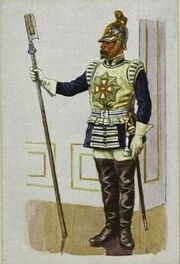
Sketch of Papal Guard.
Captain-General of the Holy Church[]
Title: His Excellency, Protector of the Holy Church, Leader of the Papal Armies, Grand Crusader, and Faithful Servant of God.
(Canrillaişe: Son excellence, protecteur de l'église sainte, Amorce des armées papales, croisé grand, et domestique fidèle de Dieu.)
The rank of Captain-General is currently held by Francesco Cesare de Borja. The Papal Guard of the Theognosian Church are known to fight over ranks, Arch-Patriarch Pius II decreed that a new rank of Captain-General of the Holy Church shall be created in order to restore order in the Papal Armies. The Captain-General is regarded as an important rank for anyone who wish's for adventure and respect from the Patriarchal Community.
Structure[]
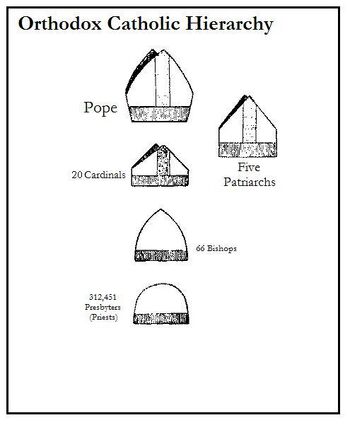
Diagram of the Theognosian Church hierarchy.
The Structure of the Church takes place in a framework of an absolute theocratic monarchy, in which the head of the Theognosian Church, the Arch-Patriarch, exercises full power over the Theognosian Church and Ville de Saints.
Patriarchs[]
Countries with established populations of Theognosianists are granted a patriarch to lead the faithful within their borders. While the Arch-Patriarch heads the universal church, the Patriarchs head the national churches; these Patriarchs are the front runners in the replacement of a deceased Arch-Patriarch except in Kanjor where the Patriach is the sitting Monarch. There are five Patriarchs as of 2672: Rildanor, Kanjor, Alduria, Lourenne, and the one of Istalia-Solentia-Quanzar.
Cardinals[]
The cardinals are senior members of the Church who advice the Patriarch and the Arch-Patriarch and aid the selection of the two upon resignation or death. There are a total of 30 cardinals:
- Rildanor: 5
- Kanjor: 5
- Kalopia: 5
- Solentia: 5
- Alduria: 2
- Lourenne: 2
- Istalia: 2
- Darnussia: 2
- Keymon: 1
- Other: 1
Bishops[]
The bishops, who possess the fullness of the priesthood, are as a body (the College of Bishops) considered the successors of the Apostles and are constituted Pastors in the Church, to be the teachers of doctrine, the priests of sacred worship and the ministers of governance. These bishops play an important role in the administration of the individual national churches and the local communities within them, as well as advising the national Patriarch on all matters of faith and administration. There are 80 bishops located around the world:
- Rildanor: 20
- Kanjor: 20
- Solentia: 14
- Alduria: 7
- Lourenne: 7
- Istalia: 7
- Darnussia: 5
- Keymon: 2
- Other: 5
Affiliated Parties[]
- Kanjoran Patriarchal Traditionalist Party
- Parti d'Aristocratie
- Parti démocrate-chrétien de Kanjor
- Democratic Socialist Party of Beiteynu
- Ierós Naós
